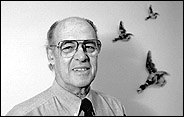Pain pioneer earns Killam Prize
The first question a patient waiting in an emergency room often fields from a nurse or doctor is "Where does it hurt?"
 Emeritus professor Ronald Melzack
Emeritus professor Ronald MelzackPHOTO: Owen Egan |
|
Emeritus psychology professor Ronald Melzack has carved out an international reputation for himself by supplying the world with new insights into "Why does it hurt?" and "How does it hurt?" as well as "Where does it hurt?"
His work has garnered many honours, the most recent of which is the Killam Prize. Valued at $100,000 and awarded by the Canada Council for the Arts, the prize recognizes outstanding career achievement in the natural sciences, health sciences and engineering.
When Melzack was a researcher at the Massachusetts Institute of Technology in the early '60s, shortly before he returned to McGill where he earned his PhD in 1954, he and Patrick Wall proposed a whole new framework for understanding how our body processes pain signals.
The prevailing view back then was that pain was a fairly straightforward phenomenon; bang your toe against a coffee table and you'll soon be wincing.
Melzack and Wall believed it wasn't quite that simple.
Their "gate control theory of pain" argued that other sensory inputs and psychological factors play a major role in determining how we experience pain. The theory was not, Melzack recalls, an instant hit with other pain specialists.
"People didn't like the idea at all. The first papers that came out about our work for the first year or two set out to destroy the theory."
But the theory slowly began to gain converts as specialists took note of the way different people experienced pain.
"There are examples of soldiers at the battlefront who have suffered severe injuries, but they feel no pain initially," says Melzack. "What they know is that they're still alive, they've escaped death, and the brain might process [the pain signals] almost as a good thing.
"Then you might see someone with mild gas pain who is experiencing it as intolerable pain because his close friend is dying from stomach cancer and that's what he's thinking about."
Melzack and Wall argued that certain nerve cells act as a kind of tap, opening up or shutting down the processing of painful stimuli.
Dismissed initially, Melzack and Wall's paper went on to be classified as a citation classic because it was referred to so often by other scientists. "Usually with an influential paper, there are all kinds of citations at first and then it sort of dribbles away. Our paper was the complete opposite." Largely ignored at first, the citations slowly began increasing "and it went up and up and up."
Apart from the gate control theory, Melzack is probably best known for developing the McGill Pain Questionnaire, a diagnostic and research tool used in hospitals and labs around the world. Melzack notes that a pharmaceutical company just had the questionnaire translated into 12 different languages for a major new international study.
The questionnaire stems from interviews Melzack had with patients suffering from pain. "Patients often had a hard time talking about what the pain felt like." So Melzack decided to make the process easier for them, offering over 100 words such as "shooting," "stabbing" and "creeping" to choose from. The distinctions are important, he notes, as they can point to different sorts of illnesses or injuries.
Melzack's contributions to our understanding of pain are so varied, it's hard to broach the subject at all without his name coming up.
He determined that short-term pain -- the sort caused by a paper cut, for instance -- is processed by a different set of pain-signalling pathways than the ones which deal with prolonged pain caused by such things as a chronic back condition or cancer.
His work on "phantom pain," how people still experience painful feelings in body parts they no longer have or never had, suggests that the brain carries its own "map" of our bodies. This map is so influential, it provokes sensations in body parts that don't exist because the map knows that there is supposed to be an arm or a leg where there isn't one.
Melzack has also been an influential voice in how we treat pain. He has long urged doctors not to cheat their patients out of proper pain control because of worries that the patients might become addicted to morphine or other drugs. As Melzack notes, studies indicate that morphine taken solely to control pain is not addictive.
His McGill colleague, nursing professor Celeste Johnston, is president of the Canadian Pain Society, an organization that is currently trying to raise awareness among patients that they have a right to have their pain properly treated.
It's a goal that Melzack heartily endorses. "Most patients keep quiet because they don't want to be seen as complainers. They want to be liked by their doctors and nurses."
Melzack is now officially retired as a researcher. His last graduate student graduated last year. Nevertheless, he is still keeping busy. As the editor of The Textbook of Pain, Melzack is responsible for periodically updating the influential tome, used widely by universities and pain specialists. He is editing a pared down version of the book for specialists that leaves out a lot of the more basic material that is used for teaching students. "It's 1,500 pages long. You just can't lug a book like that to the pain clinic everyday."
He is also busy writing a book about perception that is linked to some of his insights into how we process pain. "It's about how we perceive the world around us and how nerve impulse patterns make us feel all the things that we feel."

